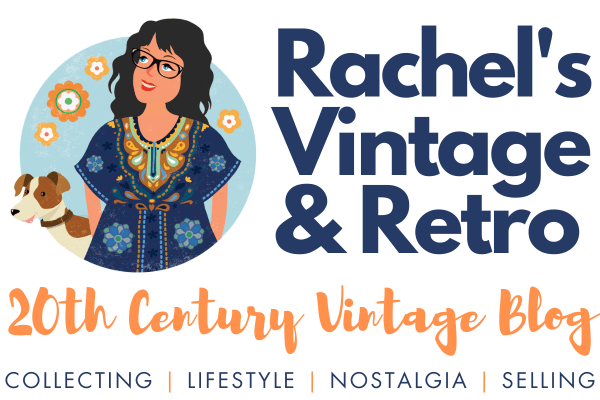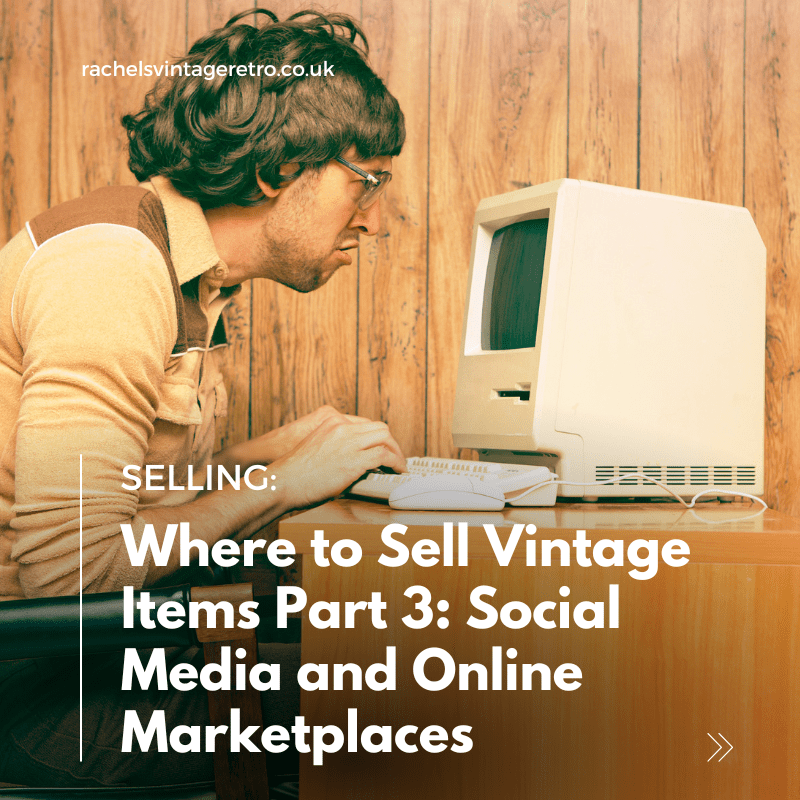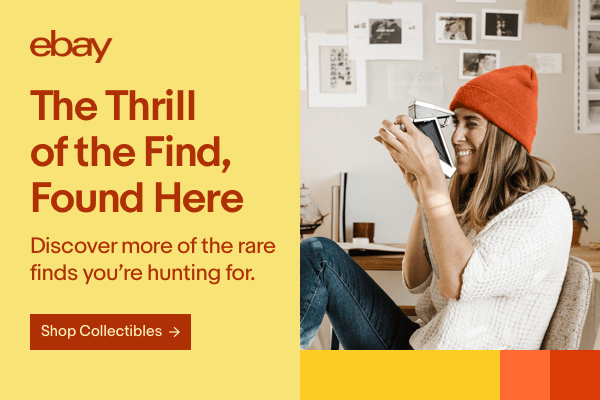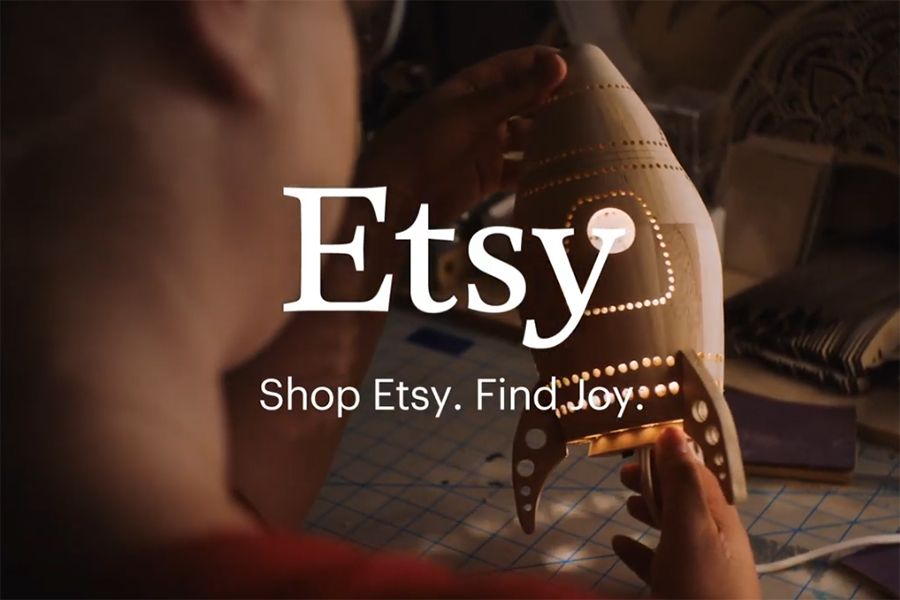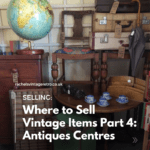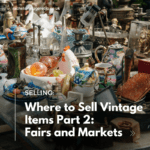In the third of these series of articles, I discuss where to sell vintage items: social media and online marketplaces. I reveal what it is like to sell vintage online, one of the best places to connect with buyers, as well as some best practices and top tips to help avoid the scammers. The previous articles are here; Part 1, Selling at Car Boot Sales and Part 2: Fairs and Markets.
Where to Sell Vintage Online
You have several options available to you if you wish to sell vintage online, and my advice is to try them all at least once, eventually whittling it down to one or two platforms that work for you. Do remember that online marketplaces and social media are ultimately in control of the data you have on their platforms, and can change selling rules, policies, algorithms, layouts etc whenever they like. These could all affect your business overnight, for the better, or most usually, for the worst!
Social Media
When social media began to gain popularity in the late 2000s / early 2010s, platforms such as Facebook and Instagram saw the potential of offering ways to sell items to your own social media network. This included personal selling on Facebook Marketplace, or setting up a shop on a professional / business page. It has since grown considerably and millions of people all over the world use social media to buy and sell items. This is a game changer for online selling as now selling business, don’t always need a website. Selling on social media is a good way to learn the basics, but I would recommend that you do create your own website eventually.

How to set up on Facebook:
- Create your own personal profile if you haven’t already, to act as an administrator for your Facebook page. You don’t need a page if you want to sell on Facebook marketplace only.
- Create a Facebook page for professional use and add your logo plus about section and contact details. Make the about section as informative as possible, so visitors know what to expect from your page.
- Invite all your friends so you have an instant following! Ask them to invite their friends too or share your posts.
- Start posting interesting updates on your Facebook page not related to selling as people don’t want to feel they are being sold to all the time. You can schedule posts to help save you time via Meta Business Suite.
- Then inter space with sales posts; you will need some good pictures of the item from all angles, and indicate it is for sale. It is good to include details of any flaws, plus the price and how to buy / pay you. This is usually paypal or bank transfer when just starting out (so make sure you have a paypal account!).
- You can also do live sales on Facebook as well as single posts. I usually post photos of a table of goodies, then encourage people to ask for prices during a specified time window. This way you can get a lot of sales in one evening.
- If selling on Facebook marketplace, it is best to do so as an individual, so use your own personal account. Go to the marketplace icon from your phone or desktop browser and tap sell to get started. This is a more formal style of listing items with title, picture, description and price fields to fill in. The more details the better as it helps you to get found by more people looking for specifics.
- You can also share your listings in local selling groups on Facebook so make sure you join a few of those.
- A word of warning for Facebook marketplace, there are A LOT of scammers out there! Never give personal details such as date of birth etc on a message, and beware of anyone who asks you to email them away from Facebook messenger.
- Build up trust as a seller on Facebook, ask for reviews wherever possible and share the good ones!
- At the time of writing it is free to sell on Facebook, the only costs you may encur is payment provider fees such as Paypal, and postage. It is usually expected that buyers cover this though and you quote this at point of sale.

How to set up on Instagram
- Install the app on your phone or tablet as it isn’t designed to work from a desktop browser.
- Set up a profile, or add a new Instagram account using the option on your current profile. Enter your new username and fill in all the details when prompted. Again make sure to include details so that people know what to expect.
- Instagram has always been a place for beautiful photos, so make sure any product photos are creative and perfect! This will help you to stand out and gain a reputation.
- You can use it to sell individual items and live sales in the same way as Facebook above but it doesn’t have a separate marketplace.
- Instagram stories are also a good place to share your sales posts.
- Reels are becoming more popular on Instagram (and Facebook), so be sure to include some videos of your products too.
- At the time of writing it is also free to sell on Instagram (see Facebook info above).
With both Facebook and Instagram you can also link your page to your website to tag products on a post. I will detail how to do this in my next post of the series, selling vintage via your own website.
Selling on other social media platforms
More recently other social media platforms such as Tiktok, Youtube and Pinterest have allowed social selling. These can appeal to new audiences you may not have yet thought of. I don’t have any direct experience of these but if you do, please share in the comments below!
Online Marketplaces
The first online marketplace was eBay, launched in 1995, and it instantly changed how people bought and sold antiques, collectables, and vintage items. Now people could find out how much items were worth, and sell to a much larger audience. This upset a lot of old school dealers as they lost sales to younger, more web savvy entrepreneurs.
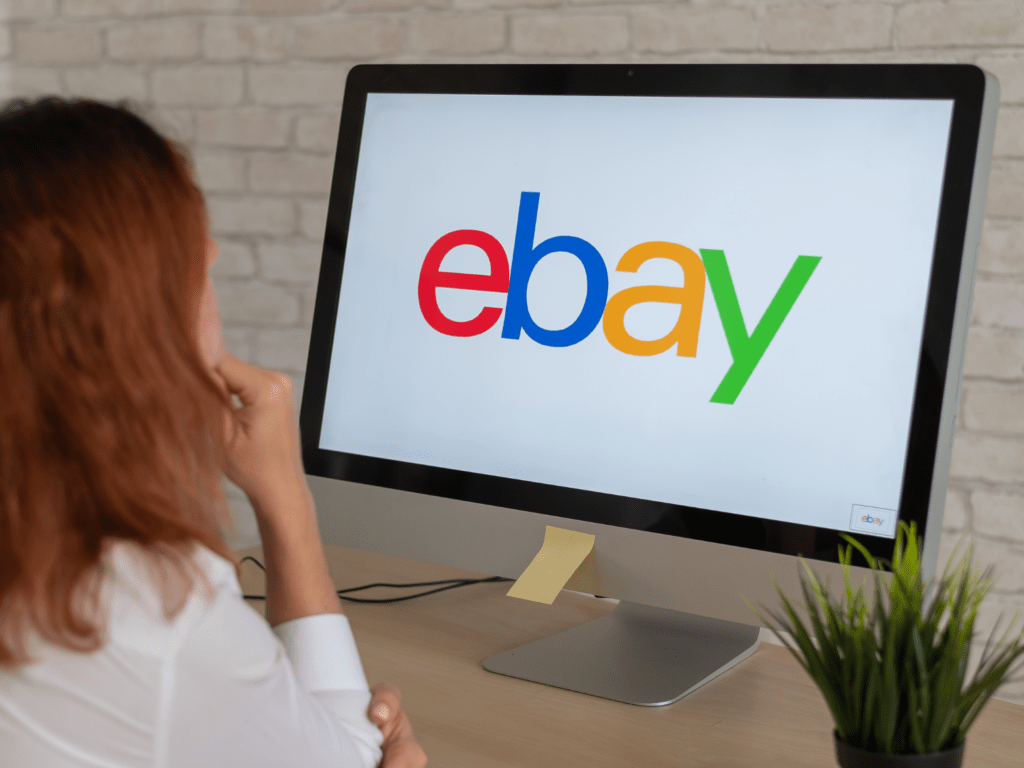
Selling on eBay
The format of the website is pretty much the same today, with a massive database of items to buy, whether its preloved, new or refurbished. Lots of new features have been introduced over the years, such as the Buy it Now button and eBay motors. The key to successful selling however, is feedback which was initially introduced in 1997 to help create and open, fair marketplace.
You can be a successful seller on eBay but there are many hoops to jump through in order to do so! It’s probably best to start as a private seller before you set up a shop or business account. In this way you can learn the ropes as you go. The main reason for this is because you will probably make a lot of mistakes initially, and fall foul of difficult buyers. Your feedback will reflect this, so is better to wait until you are confident you will achieve mostly good feedback before you take the next step as a business seller.
Good feedback will also help the visibility of your listings too, as eBay uses customer satisfaction as part of their algorithm. Top rated sellers get the instant benefit of higher positions in their listings, so is worth doing the work to become one. You will need to have a history of on-time deliveries, plus minimal returns to become a top rated seller too.
Other tips for visibility include good photos, and including keywords into your item title. Try to include what you think buyers will search for, and brand names are always good. Fill out the item specifics on a listing too, even if it seems tedious as people will be searching by size, colour etc more than you think!
Finally there are some horrible buyers on eBay who are ready to complain at the slightest little thing, or say the item is not received, in order to get a full refund or discount. To help combat this you need to make sure every little flaw is detailed on your listings, in the photographs as well as product description. Also use a trackable service when sending out items and keep the send receipt.
If this doesn’t put them off they will then use the fact it’s not as new to try it on, but as you will be selling vintage, this is not a valid claim. Contacting eBay in the most difficult of cases, plus reporting the buyer is usually the best thing to do with the most persistent ones. You can also ask the buyer to revise any bad feedback and appeal against unfair feedback directly to eBay customer service.
It is now free to sell on eBay for UK-based private sellers (this is in response to Vinted). You get 300 free listings every month. Once you’ve used all of your free listings, eBay charge 35p for each additional listing you create that month. You may also pay fees for optional listing upgrades or if you deliver to an overseas address.
Its slightly different for Business sellers however as eBay charge two main types of fees when you sell with them – fees when you create your listing , and transaction fees when your item sells. You can set up a Shop subscription to save on fees. A basic shop is £27 + VAT and you get 250 free fixed price listings and 200 auction style for that. You also still need to pay a final value fee, which varies according to category. More information for private sellers and business sellers.
Even though it seems daunting, selling on eBay is an excellent way to learn the basics of online selling, and you can build up a loyal following ready to move onto your social media and / or own website when ready.
You can create an eBay account here: https://signup.ebay.co.uk/pa/crte
Selling on Etsy
At about the same time that social media took off, other online marketplaces such as Etsy were beginning to gain more market share, as people wanted more specialist
sites than the general massive eBay marketplace. Etsy began as a place for
craftspeople and vintage sellers to reach their own audience, however it has since
started to allow mass produced products to be listed also (which is a shame_. More recently Etsy have also introduced more eBay style policies for buyers and sellers, to help protect against unscrupulous ones. It also has a feedback system to help find the most reputable sellers.
Etsy can be a genuine alternative to selling on eBay, especially as it is more geared to vintage and beautifully made items. So hopefully you will get more appreciative buyers! You can also sell alongside eBay (just be sure to manage your inventory well!).
Payments are held in an Etsy payment account and you can set a deposit schedule. Note that the website states they may put a hold on payments for various reasons. I must admit that this, alongside allowing mass produced items on the site, is why I no longer sell on Etsy! More information here https://www.etsy.com/uk/legal/etsy-payments/.
Etsy Listing fees are set at $0.20 per item, then you pay a transaction fee of 6.5% for a sold item. There are other optional fees to pay such as for advertising, or setting up your own selling website via their website builder, Pattern. Etsy also offer a subscription for $10 per month which covers 15 listing credits and $5 in ad credits. So you need to take these into account when calculating if it is worthwhile (and the same for eBay above). Sometimes it isn’t! For more information go to https://www.etsy.com/legal/fees/.
You can join Etsy by tapping the image below (contains affiliate link)
Selling on other online marketplaces – Vinted, Depop, Shpock etc
In more recent years there has been a rise in indie online marketplaces such as Vinted, Narchie, Shpock, Preloved and Depop. These are predominately presented in the form of mobile apps and aimed at younger consumers. Newcomers like this have disrupted the market so much, that they have even prompted some of the older brands to change their policies and attract a younger audience. For example eBay now allow you to sell your items for free, in a move to compete with Vinted who have been offering that from the start. Most of the apps are dedicated to selling preloved clothes, although some allow you to list homewares too.
I don’t have any personal experience of selling on these marketplaces, as I have now moved on to selling via my own website. However if you have any experience on these, or top tips in selling, please do share below!
Please note this post contains affiliate links for which I may earn money as a result of any purchase.
This blog post is written by Rachel Toy, owner of Rachel’s Vintage & Retro. I am a 20th Century Vintage Blogger and Dealer writing about the vintage lifestyle, collecting, nostalgia and selling vintage. I also sell carefully curated 20th century antiques and collectables from my online vintage shop. I am happy to work with related brands on collaborations and also accept guest blogs. Find out how to work with me.
